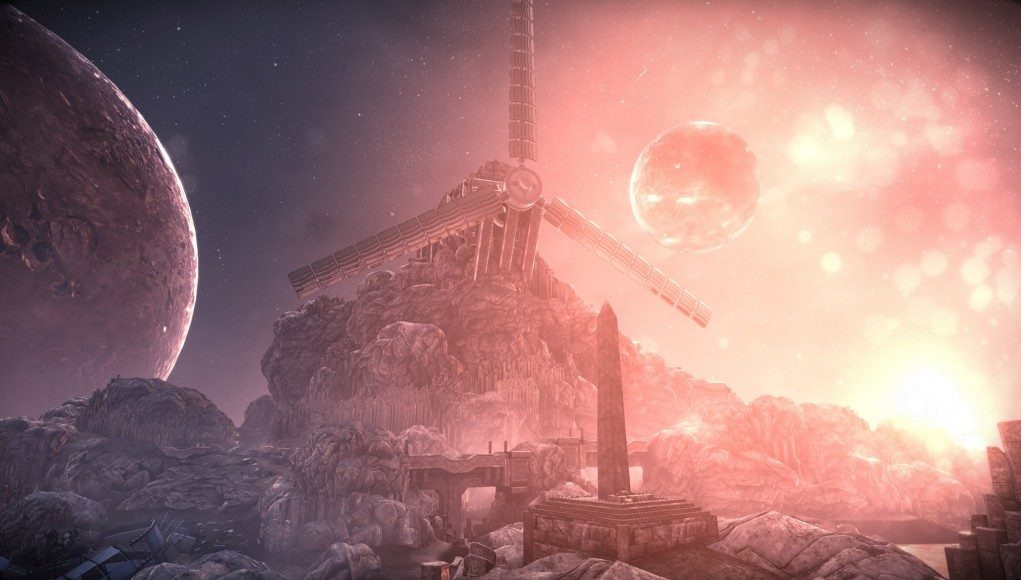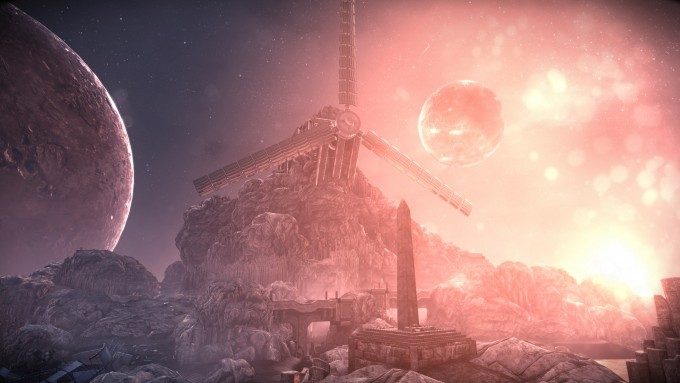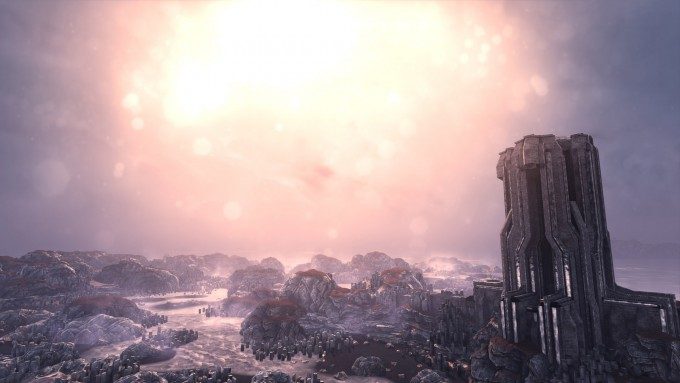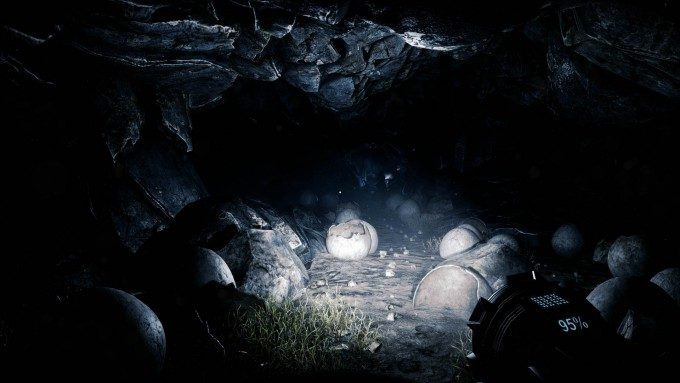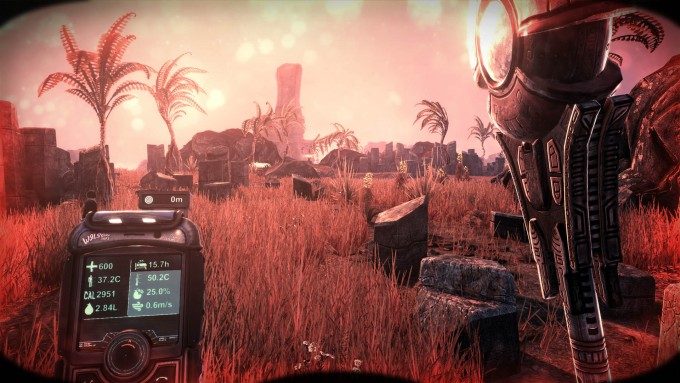The Solus Project from Grip Game and Hourences is a beautiful, atmospheric, and occasionally terrifying VR sci-fi adventure-survival game.
The Solus Project Details:
Official Site
Developer: Hourences and Grip Games
Publisher: Teotl Studios
Available On: Steam (Oculus Rift & HTC Vive)
Reviewed On: HTC Vive & Oculus Rift
Release Date: June 7th, 2016
Note: The VR component of this game is still a work in progress which means the developers have deemed it incomplete and likely to see changes over time. This review is an assessment of the game only at its current state and will not receive a numerical score.
After an extended period in Early Access, The Solus Project launched earlier this year for non-VR gamers and the critical reaction was mixed, with its blend of survival and storytelling missing the mark for some. Fast forward a couple of months to July and developers Hourences and Grip Games delivered a massive update that implements what they describe as “work in progress” VR support. Although technically not finished, this VR experience for Oculus Rift and HTC Vive offers a lot more than you might expect and leaves a lasting impression of its strange, alien world. Can VR elevate The Solus Project to new heights?
Gameplay
There’s a moment in most people’s lives where they confront their irrational fear of the dark. Standing in pitch black, hair on the back of the neck stands on end as primal instincts woven into the animal parts of our DNA collide with the rational brain that knows there’s nothing to fear. The Solus Project in VR delights in messing with those lingering animal instincts.
Another in a long line of in-vogue survival games, The Solus Project sensibly lets the threat of your imminent demise fade into the background. Exploration and a sense of mystique are more important than making sure you have enough burgers and Coke to survive.
Starting in orbit around a distant world as part of a crew tasked with finding humankind a new home, disaster strikes and your ship crashes spectacularly onto the surface. You find yourself alone on an alien world surrounded by twisted metal and flames. Survival is the first order of business as you rush to meet your basic needs; huddled in a cavern against the freezing cold, but you need to press on. Are there other survivors? Can you make contact with anyone back home? Will you ever get off this planet? If you want to find out, you will need to leave the relative safety and warmth of the crash site.
At first you will explore timidly, greedily gathering nearby supplies and rapidly filling your inventory, before building enough confidence to strike out further and further. This is a rare game that makes you feel like you are embarking on a journey into the unknown; one that will take you across alien terrain, through caves, and deep underground. Inside VR, The Solus Project has an incredible sense of place, of scale, and of wonder. This is a singularly alien world with moons that loom large on the horizon, throwing the outline of distant and enigmatic shores into sharp relief, and it only becomes more unsettling as you make your way through the game’s eight hour run time.
Most of your time is taken up with the exploration of large though not vast areas, incurring loading screens as you move between them via caves or tunnels. You’re going to need to bring some light with you because there’s a full day-night cycle and when you find yourself underground the world falls into an ominous pitch black. You will cower at strange sounds and imagined movement from beyond the aura of your flaming torch, or the eerie glow of luminescent shards. There will be objects to discover and collect as you solve rudimentary puzzles and combine items to overcome obstacles. The more things you find the more things you can do and therefore the more progress you will make towards your goal.
The survival elements of the game will require you to find food, water and medical supplies, all of which follow sensible rules: if you’re active, you’ll burn through calories and water, both of which will need to be topped up with food and good old H2O. Go out in the cold and you’ll expire through hypothermia; get wet and then go out in the cold and you’re going to very quickly turn into a popsicle. Try not to fall off a cliff, as this has predictable consequences. Rain storms and meteor showers—genuinely terrifying the first time—ensure that even getting from A to B isn’t always as simple as you’d imagine. Your trusty PDA holds all the key information you will need, and the computerised voice of your suit will delight in telling you your condition; “Operator wet,” nice observation, genius, it’s raining!
As good as the setting is, the game does indulge itself with some clunky storytelling at times. At one early point your character delivers a monologue to impart some sudden realisation… except it’s not sudden, and you will have had this realisation yourself a good half an hour earlier. You are left to construct much of the backstory yourself, by observing your surroundings and reading crew logs conveniently strewn about the place. It’s good to know that even in the distant future humankind still write their logs on paper. Fireproof, crash proof, waterproof paper.
Compounding the inconsistent quality of the storytelling is the fact that the VR support isn’t final, with the game itself referring to it as a work in progress, and this does intrude on the fun from time to time: the tutorial is poor, regularly it’s evident that the environment wasn’t built for VR navigation, there are occasional UI oddities, and the controls can be really fiddly. Over time I’m hopeful that those rough edges will be smoothed away, especially given the already impressive support, but be aware that the present build will require you to make more effort than most other games would demand. Once you have spent some time playing it all starts to make sense, however. The interface is fairly complex; it’s convoluted, but it’s fully functional and after an hour or so becomes almost second nature.
The Solus Project offers up a very compelling world to explore and secrets to unravel. Revealing too much of the story or the setting would be to ruin the sense of unfolding mystery the game builds so well. It wasn’t built with VR in mind, but aside from some clunky interface and control issues you wouldn’t know. It is a world that begs to be experienced in VR… unless you’re afraid of the dark.
Immersion
I can’t overstate how atmospheric The Solus Project can be. The day night cycle, the ominous looming moons, the distant shores, the strange architecture all combine to form a cohesive world – ambient sound effects and music combine well to round out the mood. Standing on a shoreline watching the waves roll in as a meteor shower explodes around you and a moon crests the horizon never gets old. As the rain started to fall heavily I felt exposed, and then genuine relief when finding some cover and standing under it. Caves with roaring fires feel almost cozy after being exposed to the wild surface of the planet. Pushing deeper into a cave, with only your small nimbus of light to see by, is exactly as uncomfortable as it sounds. At times I was completely immersed in the illusion.
There are some UI oddities that break the immersion somewhat: when you take a fall the glass in your helmet cracks, but it doesn’t feel like you’re wearing an helmet, it just looks like a perfectly in focus texture right up against your eyeballs. Same with the moisture effects when you’re caught in the rain. They’re neat effects, but not quite pulled off in VR. The focus dot in the centre of the screen also occasionally zooms toward you distractingly, as it focusses on something near to you – not a bug so much as the non-VR version peeking through. There’s the Rift bug when you sleep and the screen fades to black everywhere except at the extremes of your vision where you can still see through to the world. The loading screens are also just black empty screens, with the loading indicators slightly visible just out of your field of vision on the Vive.
Your main tool throughout the game is a chunky PDA that is ever-present in your left hand, but you also use your left hand to target the slightly twitchy system for Vive teleport motion; it only works when targeting a flat surface which makes, for example, climbing a staircase a lot more annoying than it needs to be. In your right hand is the currently active item from your inventory, in my case this was a flaming torch 90% of the time. The right hand also functions as a laser pointer for things that your PDA can examine. On the Rift these items appear in fixed locations that track with your gaze; suffice it to say this feels more like the non-VR version of the game and loses some immersion as a result, and you must use your head to point at items in the world rather than your hand as with the Vive.
In both cases it can be a little difficult to keep your arm or head steady as you wait for the readout on your PDA to tell you what you’re looking at; if you lose focus on the target the scanning process resets which became frustrating very quickly. The Vive’s motion controllers are more natural here, as you point imperiously at your target with one hand and raise the other closer to your eyes to get a better view of the readout in true Star Trek Tricorder fashion. After a while playing with the Rift I grew more adept at just shifting my gaze slightly rather than my head, but it is a distraction that took me out of the experience.
Using the Vive’s VR controllers and holding a torch in your hand, sweeping around and illuminating the environment, makes you feel much more the rugged explorer; there’s a real Tomb Raider quality to some of the environments and reaching my arm high above my head to expose details of a cavern was a constant delight. When I first jumped down into a pool of water the torch was doused and I was plunged into terrifying darkness. I had a visceral panic response, and scrambled to reignite it. Through my own stupidity I had my hand too low and let the torch hit the water, and thereafter I became much more aware of my limbs and the world around me. The game became much more real to me as a result. Using a traditional controller just isn’t the same. Given the impressive support from the developers so far I’d imagine Oculus Touch support will be added to The Solus Project later in the year, and that really would be the better way to play compared to a gamepad.
Comfort
HTC Vive users are offered a teleportation solution for getting around the world, although this is slightly confused by there being an actual teleporting tool you get in the game which becomes a core part of some later puzzles. There are those that find teleporting around a VR world completely breaks the immersion, and for them there’s the option to directly control your forward and turning motion with the track pads. When using this method of locomotion, the direction of travel is wherever your head is pointed, but the track pad can also be used to swing your view around.
Oculus Rift users lose the teleportation option, but retain everything else and gain the ability to strafe. Both sets of users get a comfort mode option that snaps turns to 90 degrees and also have the ability to reduce walking speed from 100% down to whatever they find comfortable. Best of all, the game lets you mix and match. I am highly susceptible to simulator sickness, so many games with joystick have been known to ruin me for hours after taking off the headset. But there are also times when teleportation—especially in games where it wasn’t designed in from the start—can be an hinderance or reduce the immersion. The Solus Project doesn’t make you choose one or the other, you can move between them as you wish while you play.
I found my perfect balance to be the Vive with a combination of teleportation, with occasional snap-to-turn to untangle me from the cables, and smoothly moving forward with direct control of my forward motion using my gaze to fine-tune. When first exploring an area I’d take direct control to soak up the ambiance, but when I was backtracking or just wanted to get somewhere fast, the teleportation is excellent and actually lends the game a feeling not unlike the original Myst or the recent Obduction. This lets me choose how much of the joystick locomotion I wanted from moment to moment, rather than having to make an upfront choice or, worse, not having a choice at all.

Using joystick locomotion, you will frequently find your viewpoint jumps up and down as you walk over items in the world, or if you use the jump button. This could be uncomfortable for some, and can be avoided almost entirely by using the teleportation to move. Rift owners susceptible to simulator sickness will just have to suffer through it until/unless Touch support is patched in. That said, Rift owners will doubtless already know where their comfort limits are with these things. I found I couldn’t play The Solus Project on the Rift for more than 20 minutes before starting to feel simulator sickness kick in. If you know you have a higher tolerance, or are impervious to the effect, then you could doubtless go for much longer. Conversely, on the Vive, I was easily able to play for 90 minutes in a session without issue by using teleportation mixed with joystick locomotion.
On the framerate performance front, the game offers a lot of configuration options to give you the optimal experience for your machine. It recommends that you set detail much lower than you would normally in order to run well in VR, as you’d expect, but I found that my 980Ti and i7 6700K was able to run with almost everything cranked up to maximum. For those running closer to the entry level, you’ll want to turn down the world detail and shadow quality.
The only essential setting is supersampling, so those on less powerful machines will want to sacrifice other options to enable this. At 150% it took the PDA from an unreadable mess to a sharp, crisp readout. This will save you squinting too hard at the PDA, or bringing it so close to your eyes that you smack the controller into the headset, which totally didn’t happen to me, repeatedly, until I ramped up the supersampling.
Conclusion
Despite some rough edges The Solus Project in VR is a great experience. The eerie atmosphere is expertly built, and the game lingers with you long after you’ve removed the headset. With so many options for comfort and control, and support for both high end VR offerings, aspects of the game stand as an example that other VR developers would do well to follow.
Important Note: I ran into some severe performance issues with the game at first. This manifested itself in seemingly random spikes where the frame rate dropped low enough to break the head tracking and induce significant simulator sickness – it literally rendered me unable to go back into VR for a full 24 hours. A little bit of Googling revealed that others had suffered a similar problem, and the developers offered some INI file tweaks to address them. I had to go a step further and make a change suggested by other users but, thankfully, in the end I was able to achieve perfect frame rates and resolve the problem completely – if there was a visual trade-off for disabling these features I didn’t notice it. If you find the performance dropping, and you know your hardware should be able to cope, perhaps these INI tweaks will work for you:
In your Steam directory, find the following file:
\steamapps\common\TheSolusProject\Solus\Config\DefaultGame.ini
Then make these changes:
SmoothFPS = False
AllowOceanUpdate = False
AllowSkylightUpdate = False

